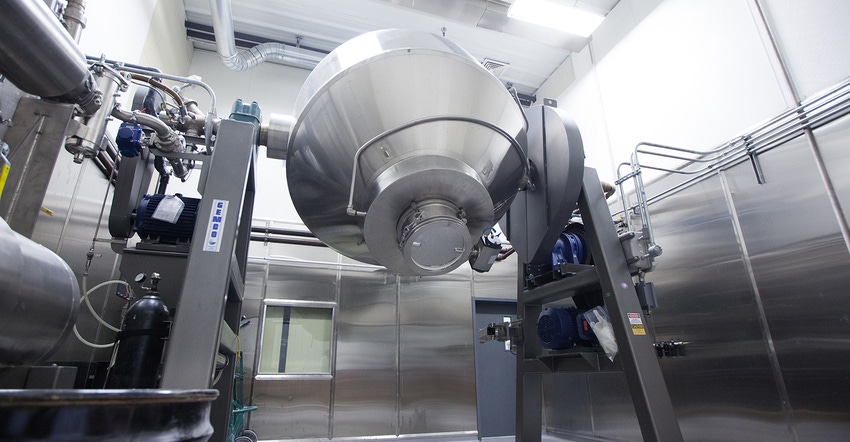Optimizing the precision blending of supplements
Tumble blending can optimize the fine mixing of many components in supplement formulations while reducing cost and substantiating label claims.

Nutraceutical ingredients can be formulated into a wide variety of health-related products, including vitamins, supplements, mineral blends and foods like energy bars. Many of these formulations involve the fine blending of as many as 40 to 50 components, including powders and trace elements.
While nutraceuticals are not regulated like pharmaceuticals, the products still must substantiate label claims, and a number are tested in clinical studies like medicines.
Whenever a nutraceutical makes a label claim, like a specific recommended dietary allowance (RDA) or FDA allowances, vitamin percentages or active components, it must meet those criteria. Further, nutraceutical products must not only avoid doing harm, but also increasingly substantiate any claims or benefits.
One industry challenge is that the blending of solid ingredients is easier and more uniform if the ingredients are approximately the same size. However, it is difficult to create precise blends with trace ingredients (less than 1%) that are dissimilar in size and density. In some cases, this might require multiple key blends in a time-consuming and costly process.
Fortunately, with tumble blending equipment that is engineered to meet the requirements of the application, the process can be simplified to produce a precise, homogenous blend containing necessary components and trace elements in the specified amounts. Such blending can eliminate the need for key blends and produce a better distribution of active ingredients.
Limitations of Traditional Mixing Equipment
Traditional equipment such as plow, ribbon and paddle mixers, which use blades or paddles to push material, are limited to moving the material within the confines of their active area. The mechanics force the material bed outward, leaving dead spots inside the vessel where material moves more slowly or remains stationary. A stationary port at the bottom of such machines further isolates the material.
Another issue lies in the positioning of the intensifier bars, which should ideally be in the mixing zone, where every particle passes through. Many times, however, traditional mixers position intensifier bars in dead zones, resulting in material not being fluidized properly and active ingredients getting incorporated throughout the batch.
Traditional mixers can also waste expensive additives. Because additives initially contact only a small portion of material in the vessel, they get absorbed into the material bed, so more additives are usually needed to achieve the desired mix concentration, which increases cost.
Benefits of Tumble Blending and Vacuum Tumble Drying
To address the deficiencies of traditional mixers, a growing number of nutraceutical manufacturers use tumble blending. Tumble blending is commonly used to create precise nutraceutical blends that contain trace ingredients (less than 1%) that are vastly dissimilar in size and density.
In contrast to traditional mixing, to eliminate dead spots, tumble blenders apply even turbulence in all corners of the mix through a combination of macro and micro blending. This can eliminate the need for key blends and produce a better distribution of active ingredients.
Macro blending is achieved by rotating the shaped vessel, allowing the material bed to fall away from the vessel’s walls. Tumble blender vessel shapes are engineered to create a repeatable pattern in which the entire bulk material moves to form a homogenous mixture. The blender moves at a precise speed, with the vessel wall at a precise angle, so that the material cascades over itself. The paddles, plows or spiral ribbons don’t apply additional force; they use gravity.
While this occurs, micro mixing (if needed) simultaneously proceeds via agitator blades located in the mixing zone center of the vessel, where fine processing in the material transpires. This allows for a gentle, repeatable pattern that maintains a superior blending design while preserving the product’s physical characteristics.
As an example, a large nutraceutical manufacturer in Nevada with an approximately 40-component blend was not utilizing an agitator and had a laborious, overly complex blend process. To make about 1,000 kilos of product a few times a year involved six or seven separate steps with key blends that had to be lab tested after each step to reach a final blend with the necessary traceability, materials and active components.
For nutraceutical manufacturers that have sought to ensure product quality through the fine blending of many components, but were unsatisfied with traditional methods, tumble blending can help optimize the process. With greater process control, manufacturers will be able to reduce blending steps and cost while substantiating label claims and clinical trials.
Casey Muench is president of GEMCO, a manufacturer of tumble blending and vacuum tumble-drying equipment.
About the Author(s)
You May Also Like






.png?width=800&auto=webp&quality=80&disable=upscale)